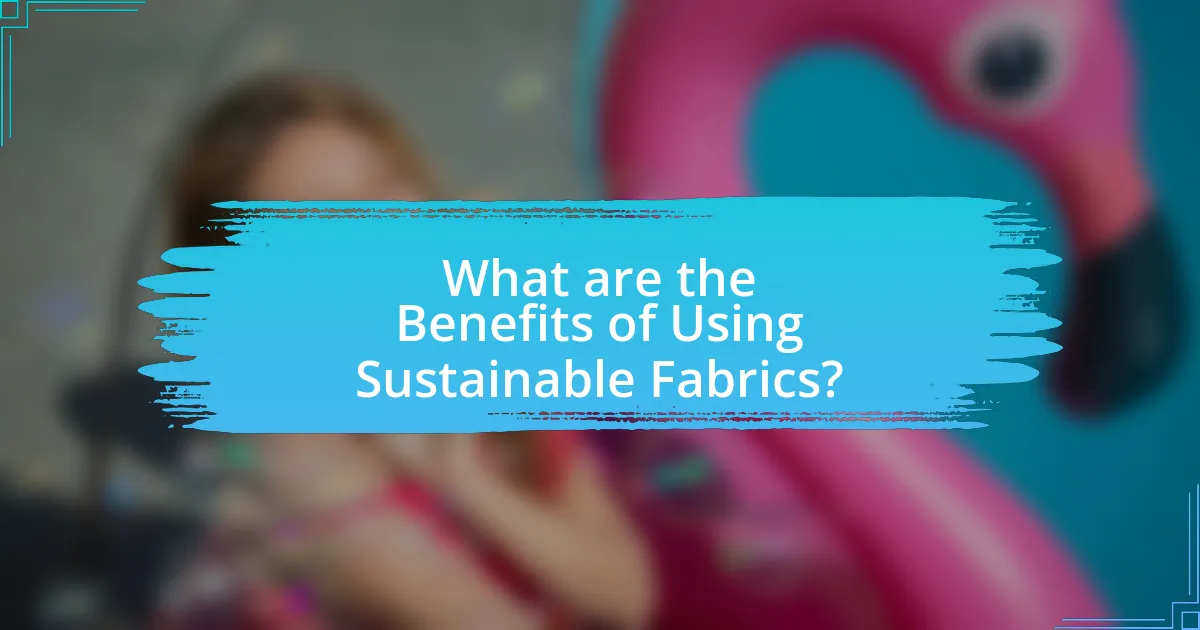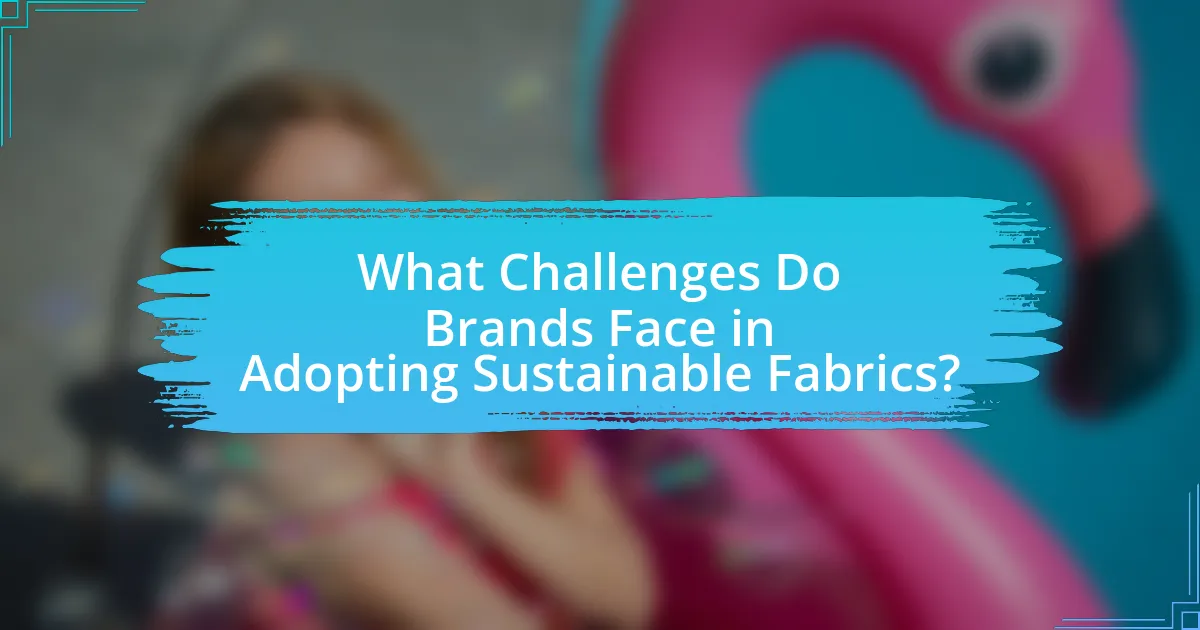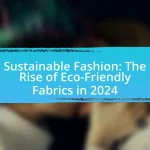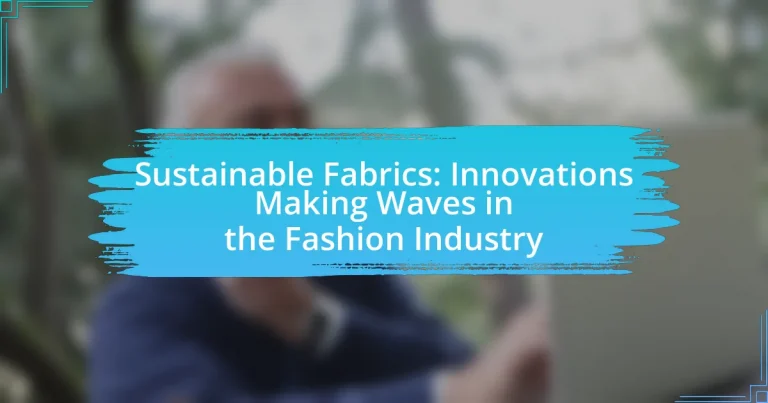Sustainable fabrics are materials produced with minimal environmental impact, utilizing renewable resources and eco-friendly manufacturing processes. This article explores the significance of sustainable fabrics in reducing pollution, conserving water, and decreasing reliance on fossil fuels within the fashion industry. It examines the differences between sustainable and conventional fabrics, highlights various sustainable materials such as organic cotton and recycled polyester, and discusses the environmental impact of fabric production. Additionally, the article addresses innovations driving sustainable fabric development, the role of technology, and the benefits of using eco-friendly materials for consumer health and the economy. It also outlines the challenges brands face in adopting sustainable practices and offers strategies for consumer education and collaboration within the industry.

What are Sustainable Fabrics and Why are They Important?
Sustainable fabrics are materials produced with minimal environmental impact, often utilizing renewable resources and eco-friendly manufacturing processes. They are important because they help reduce pollution, conserve water, and decrease reliance on fossil fuels, contributing to a more sustainable fashion industry. For instance, organic cotton uses 91% less water than conventional cotton, and recycled polyester diverts plastic waste from landfills, showcasing the tangible benefits of sustainable fabric choices.
How do sustainable fabrics differ from conventional fabrics?
Sustainable fabrics differ from conventional fabrics primarily in their production processes and environmental impact. Sustainable fabrics are made from renewable resources, such as organic cotton or recycled materials, which reduce reliance on fossil fuels and minimize waste. In contrast, conventional fabrics often utilize non-renewable resources and chemical-intensive processes that contribute to pollution and resource depletion. For example, the production of conventional polyester, derived from petroleum, emits significant greenhouse gases, whereas sustainable alternatives like Tencel, produced from sustainably sourced wood pulp, have a lower carbon footprint and utilize closed-loop processes that recycle water and solvents. This distinction highlights the commitment of sustainable fabrics to environmental stewardship and resource conservation.
What materials are considered sustainable in the fashion industry?
Sustainable materials in the fashion industry include organic cotton, Tencel (lyocell), hemp, recycled polyester, and organic linen. Organic cotton is grown without synthetic pesticides or fertilizers, reducing environmental impact. Tencel is produced from sustainably sourced wood pulp and uses a closed-loop process that recycles water and solvents. Hemp requires minimal water and no pesticides, making it an eco-friendly option. Recycled polyester is made from post-consumer plastic bottles, diverting waste from landfills and reducing reliance on virgin materials. Organic linen, derived from flax plants, is biodegradable and requires less water than conventional cotton. These materials collectively contribute to a more sustainable fashion ecosystem by minimizing resource consumption and environmental harm.
Why is the environmental impact of fabric production significant?
The environmental impact of fabric production is significant due to its extensive resource consumption and pollution generation. Fabric production often requires large amounts of water, with the textile industry accounting for approximately 20% of global water pollution, primarily from dyes and chemicals. Additionally, the process contributes to greenhouse gas emissions, with estimates suggesting that the fashion industry emits more carbon than international flights and maritime shipping combined. These factors highlight the urgent need for sustainable practices in fabric production to mitigate environmental harm.
What innovations are driving the development of sustainable fabrics?
Innovations driving the development of sustainable fabrics include the use of bio-based materials, recycling technologies, and advanced manufacturing processes. Bio-based materials, such as those derived from organic cotton, hemp, and innovative sources like pineapple leaves and algae, reduce reliance on petroleum-based fibers. Recycling technologies, including chemical recycling and closed-loop systems, allow for the transformation of post-consumer waste into new fabrics, significantly lowering environmental impact. Advanced manufacturing processes, such as 3D knitting and digital printing, minimize waste and energy consumption during production. These innovations collectively contribute to a more sustainable fashion industry by reducing resource depletion and pollution.
How is technology influencing the creation of sustainable textiles?
Technology is significantly influencing the creation of sustainable textiles by enabling the development of eco-friendly materials and efficient production processes. Innovations such as biofabrication, which uses microorganisms to produce fibers, and the use of recycled materials, like plastic bottles transformed into polyester, are reducing waste and resource consumption. For instance, companies like Adidas have introduced shoes made from ocean plastic, demonstrating a practical application of technology in sustainable textile production. Additionally, advancements in digital printing and 3D knitting minimize water usage and energy consumption, further enhancing sustainability in the fashion industry.
What role do natural dyes play in sustainable fabric production?
Natural dyes play a crucial role in sustainable fabric production by providing an eco-friendly alternative to synthetic dyes, which often contain harmful chemicals. These natural dyes are derived from plants, minerals, and insects, reducing environmental impact and promoting biodiversity. For instance, studies show that natural dyes can significantly lower water pollution levels compared to synthetic counterparts, as they typically require less water and produce fewer toxic byproducts during the dyeing process. Additionally, the use of natural dyes supports local economies and traditional craftsmanship, fostering sustainable practices within communities.

What are the Benefits of Using Sustainable Fabrics?
The benefits of using sustainable fabrics include reduced environmental impact, improved health for consumers, and support for ethical labor practices. Sustainable fabrics, such as organic cotton and recycled polyester, significantly lower water usage and greenhouse gas emissions compared to conventional materials. For instance, organic cotton uses 91% less water and emits 46% less CO2 than conventional cotton, according to the Textile Exchange’s 2021 report. Additionally, sustainable fabrics often avoid harmful chemicals, leading to safer products for consumers and workers. By choosing sustainable options, consumers also promote fair labor practices, as many sustainable brands prioritize ethical sourcing and production methods.
How do sustainable fabrics contribute to environmental conservation?
Sustainable fabrics contribute to environmental conservation by reducing resource consumption and minimizing waste. These materials, often made from organic or recycled sources, require less water and energy during production compared to conventional fabrics. For instance, organic cotton uses 91% less water than traditional cotton farming, significantly lowering the environmental impact. Additionally, sustainable fabrics often utilize non-toxic dyes and processes, which decrease pollution and harm to ecosystems. By promoting the use of biodegradable or recyclable materials, sustainable fabrics help reduce landfill waste, further supporting environmental conservation efforts.
What are the long-term benefits of using eco-friendly materials?
The long-term benefits of using eco-friendly materials include reduced environmental impact, improved health outcomes, and enhanced economic sustainability. Eco-friendly materials, such as organic cotton and recycled polyester, significantly lower carbon emissions and resource consumption compared to conventional materials. For instance, organic cotton farming uses 91% less water than traditional cotton farming, as reported by the Organic Trade Association. Additionally, using eco-friendly materials can lead to healthier living environments by minimizing exposure to harmful chemicals often found in synthetic fabrics. Economically, the shift towards sustainable materials can create new markets and job opportunities, as evidenced by the growing demand for sustainable fashion, projected to reach $8.25 billion by 2023 according to a report by Research and Markets.
How do sustainable fabrics impact consumer health and safety?
Sustainable fabrics positively impact consumer health and safety by reducing exposure to harmful chemicals and promoting better environmental practices. Traditional fabrics often contain toxic substances such as pesticides, dyes, and synthetic chemicals that can lead to skin irritations and long-term health issues. In contrast, sustainable fabrics, such as organic cotton and Tencel, are produced with fewer chemicals and often utilize non-toxic dyes, which minimizes health risks for consumers. Research indicates that organic cotton farming reduces pesticide use by up to 90%, significantly lowering the chemical load in the final product. Additionally, sustainable fabrics are often biodegradable, reducing environmental pollution and its associated health risks.
What economic advantages do sustainable fabrics offer to the fashion industry?
Sustainable fabrics provide significant economic advantages to the fashion industry by reducing production costs and enhancing brand value. The use of sustainable materials often leads to lower resource consumption, such as water and energy, which can decrease overall manufacturing expenses. For instance, organic cotton requires 91% less water than conventional cotton, resulting in substantial cost savings for producers. Additionally, brands that adopt sustainable practices can attract a growing consumer base that prioritizes eco-friendly products, leading to increased sales and customer loyalty. According to a 2021 McKinsey report, 67% of consumers consider sustainability when making purchasing decisions, indicating that sustainable fabrics can enhance brand reputation and market competitiveness.
How can brands leverage sustainable fabrics for marketing purposes?
Brands can leverage sustainable fabrics for marketing purposes by highlighting their environmental benefits and appealing to eco-conscious consumers. By showcasing the reduced carbon footprint and lower water usage associated with sustainable materials, brands can differentiate themselves in a competitive market. For instance, a study by McKinsey & Company indicates that 66% of consumers are willing to pay more for sustainable brands, demonstrating a clear market demand. Additionally, brands can use storytelling to connect emotionally with consumers, sharing the journey of sustainable fabrics from production to finished product, which enhances brand loyalty and trust.
What cost implications are associated with transitioning to sustainable materials?
Transitioning to sustainable materials typically incurs higher initial costs due to factors such as sourcing, production, and certification processes. For instance, sustainable fabrics often require more expensive raw materials and advanced manufacturing techniques, which can increase the overall production costs by 20-30% compared to conventional materials. Additionally, brands may face increased expenses related to research and development for sustainable alternatives, as well as potential supply chain adjustments. However, these costs can be offset over time through benefits like reduced waste, lower energy consumption, and enhanced brand loyalty, which can lead to increased sales and market share.

What Challenges Do Brands Face in Adopting Sustainable Fabrics?
Brands face several challenges in adopting sustainable fabrics, primarily including higher costs, limited availability, and consumer awareness. The production of sustainable fabrics often incurs greater expenses due to the sourcing of eco-friendly materials and the implementation of sustainable manufacturing processes. For instance, organic cotton can cost up to 20% more than conventional cotton. Additionally, the supply chain for sustainable materials is not as developed, leading to limited options for brands. Furthermore, many consumers lack awareness or understanding of sustainable fabrics, which can hinder demand and make it difficult for brands to justify the investment in these materials. According to a 2021 survey by McKinsey, only 30% of consumers prioritize sustainability in their purchasing decisions, highlighting the need for brands to educate their customers about the benefits of sustainable fabrics.
What are the common misconceptions about sustainable fabrics?
Common misconceptions about sustainable fabrics include the belief that they are always more expensive, less durable, and less stylish than conventional fabrics. In reality, while some sustainable fabrics may have a higher initial cost due to ethical sourcing and production methods, many options are competitively priced and can be cost-effective over time due to their durability. Additionally, sustainable fabrics, such as organic cotton, Tencel, and recycled polyester, are designed to be both stylish and functional, often matching or exceeding the aesthetic appeal of traditional materials. Research from the Textile Exchange indicates that the market for sustainable textiles is growing, reflecting consumer demand for both quality and environmental responsibility.
How do consumer perceptions affect the adoption of sustainable textiles?
Consumer perceptions significantly influence the adoption of sustainable textiles by shaping purchasing decisions and brand loyalty. When consumers view sustainable textiles as high-quality, fashionable, and environmentally friendly, they are more likely to choose these products over conventional alternatives. Research indicates that 66% of global consumers are willing to pay more for sustainable brands, highlighting the importance of positive perceptions in driving market demand. Additionally, transparency in sourcing and production practices enhances consumer trust, further encouraging the adoption of sustainable textiles.
What barriers exist in sourcing sustainable materials?
Barriers in sourcing sustainable materials include high costs, limited availability, and lack of standardized certifications. High costs arise because sustainable materials often require more expensive production processes and sourcing methods. Limited availability is a significant issue, as many sustainable materials are not produced at scale, making them difficult to obtain consistently. Additionally, the lack of standardized certifications can lead to confusion and mistrust among consumers and manufacturers, complicating the sourcing process. According to a report by McKinsey & Company, only 1% of the global fashion industry uses recycled materials, highlighting the challenges in sourcing sustainable options effectively.
How can brands overcome the challenges of implementing sustainable fabrics?
Brands can overcome the challenges of implementing sustainable fabrics by investing in research and development to identify innovative materials and processes. This approach allows brands to discover alternatives that meet sustainability criteria while maintaining quality and performance. For instance, companies like Adidas have successfully integrated recycled ocean plastics into their products, demonstrating that sustainable materials can be both functional and appealing to consumers. Additionally, brands can collaborate with suppliers and industry organizations to share knowledge and resources, which can lead to more efficient production methods and reduced costs. By adopting a circular economy model, brands can also minimize waste and enhance the lifecycle of their products, further addressing sustainability challenges.
What strategies can be employed to educate consumers about sustainable fabrics?
To educate consumers about sustainable fabrics, brands can implement strategies such as informative marketing campaigns, educational workshops, and collaborations with influencers. Informative marketing campaigns can highlight the environmental benefits and production processes of sustainable fabrics, using clear messaging and visuals to engage consumers. Educational workshops can provide hands-on experiences, allowing consumers to learn about fabric sourcing, sustainability practices, and the impact of their choices. Collaborations with influencers can amplify the message, as these individuals can authentically share their knowledge and experiences with sustainable fabrics, reaching a broader audience. Research indicates that consumers are more likely to make sustainable choices when they are well-informed, as evidenced by a study from the Journal of Consumer Research, which found that education significantly influences purchasing behavior regarding eco-friendly products.
How can collaboration within the industry facilitate the transition to sustainability?
Collaboration within the fashion industry can facilitate the transition to sustainability by enabling shared resources, knowledge, and technologies among companies. When brands work together, they can pool their expertise to develop innovative sustainable fabrics, reducing costs and accelerating the adoption of eco-friendly practices. For instance, partnerships between textile manufacturers and fashion brands have led to the creation of recycled materials, such as those developed by companies like Repreve, which transforms plastic bottles into fabric. This collaborative approach not only enhances the efficiency of resource use but also fosters a collective commitment to sustainability, as seen in initiatives like the Sustainable Apparel Coalition, which unites various stakeholders to improve environmental and social practices across the industry.
What are the Future Trends in Sustainable Fabrics?
Future trends in sustainable fabrics include the increased use of bio-based materials, such as mycelium and algae, which offer environmentally friendly alternatives to traditional textiles. Innovations in recycling technologies are also advancing, enabling the transformation of post-consumer waste into high-quality fabrics, thereby reducing landfill contributions. Additionally, the integration of smart textiles that monitor environmental conditions and enhance user experience is gaining traction. According to a report by the Textile Exchange, the global market for sustainable textiles is projected to grow significantly, driven by consumer demand for eco-friendly products and regulatory pressures on the fashion industry to adopt sustainable practices.
How is the circular economy influencing fabric innovation?
The circular economy is significantly influencing fabric innovation by promoting the development of sustainable materials and processes that minimize waste. This approach encourages manufacturers to design fabrics that can be reused, recycled, or biodegraded, thereby reducing the environmental impact of textile production. For instance, brands are increasingly utilizing recycled fibers, such as those derived from post-consumer plastic bottles, which not only diverts waste from landfills but also conserves resources. According to a report by the Ellen MacArthur Foundation, transitioning to a circular economy in the fashion industry could generate $560 billion in economic benefits by 2030, highlighting the financial viability of sustainable fabric innovations.
What emerging technologies are set to revolutionize sustainable fabric production?
Emerging technologies set to revolutionize sustainable fabric production include biofabrication, which utilizes microorganisms to create textiles, and digital printing, which reduces waste by allowing for on-demand production. Biofabrication, such as mycelium-based materials, offers a biodegradable alternative to traditional fabrics, while digital printing minimizes water and dye usage, aligning with sustainability goals. These technologies are supported by research indicating that biofabricated textiles can significantly lower carbon footprints and resource consumption compared to conventional methods.
What Practical Steps Can Consumers Take to Support Sustainable Fabrics?
Consumers can support sustainable fabrics by choosing to purchase clothing made from organic, recycled, or biodegradable materials. By selecting garments labeled with certifications such as Global Organic Textile Standard (GOTS) or OEKO-TEX, consumers ensure that the fabrics meet environmental and social criteria. Additionally, consumers can reduce their overall consumption by buying fewer, higher-quality items that last longer, thereby minimizing waste. Supporting brands that prioritize transparency in their supply chains and sustainable practices further reinforces the demand for eco-friendly fabrics. According to a 2021 report by McKinsey & Company, sustainable fashion is projected to grow significantly as consumer awareness increases, highlighting the impact of informed purchasing decisions on the industry.
How can consumers identify and choose sustainable fashion brands?
Consumers can identify and choose sustainable fashion brands by looking for certifications, transparency in sourcing, and eco-friendly materials. Certifications such as Global Organic Textile Standard (GOTS) and Fair Trade indicate adherence to sustainable practices. Brands that provide detailed information about their supply chain and production processes demonstrate transparency, which is crucial for assessing sustainability. Additionally, consumers should prioritize brands that use organic, recycled, or biodegradable materials, as these contribute to reduced environmental impact. Research shows that the fashion industry is responsible for 10% of global carbon emissions, highlighting the importance of choosing brands that actively work to mitigate their environmental footprint.
What practices can consumers adopt to extend the life of their garments?
Consumers can adopt several practices to extend the life of their garments, including proper washing techniques, regular maintenance, and mindful storage. Washing clothes in cold water and using gentle detergents can reduce wear and tear, as hot water can weaken fibers. Additionally, air drying instead of using a dryer minimizes damage from heat and friction. Regular maintenance, such as repairing small tears and replacing buttons, can prevent further deterioration. Mindful storage, like keeping garments in a cool, dry place and using padded hangers for delicate items, helps maintain their shape and integrity. These practices contribute to sustainability by reducing the frequency of garment replacement, thereby minimizing waste in the fashion industry.

















